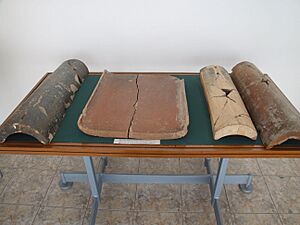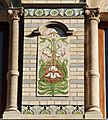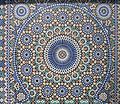Tile facts for kids
A tile is a flat piece of strong material like ceramic, stone, porcelain, metal, or even glass. People use tiles to cover roofs, floors, and walls. They have been made for thousands of years!
Tiles can be simple squares or put together to make amazing pictures called mosaics. Most tiles are made from ceramic. They often have a hard, shiny coating called a glaze on top.
Towards the end of the 1900s, new ways of making porcelain and glass tiles made them cheaper. This meant more people could use them in their homes and buildings.
Roof Tiles
Roof tiles are mostly designed to keep out rain. Long ago, they were made from materials found nearby, like clay or slate. Today, people also use materials like concrete and plastic. Some clay tiles even have a waterproof glaze.
There are many different shapes and styles of roof tiles. Each shape helps protect buildings in different ways.
People have used roof tiles for a very long time. Some of the oldest ones, made from baked clay (called terracotta), were found in Lerna, Greece. These ancient tiles are over 5,000 years old!
Images for kids
-
Art Nouveau tiles in Bruxelles (Belgium)
-
Two panels of earthenware tiles painted with polychrome glazes over a white glaze. (Iran 19thC)
-
Phoenix on the portal of Nadir Divan-Beghi Madrasah, Bukhara, Uzbekistan
-
Casa de los Azulejos, Mexico City, 18th century, with azulejos
-
17th century Delft blue and white tile with sea monster
-
Tiles in a pub in Utrecht, Netherlands
-
Floor tile in Karpas, northeastern Cyprus
-
Tilework in Jameh Mosque of Isfahan, Isfahan, Iran
-
Tile in the Topkapi Palace, Istanbul, Turkey
-
Quadra (architecture) of St. John the Baptist covered with azulejos in carpet style (17th c.); Museu da Reinha D. Leonor; Beja, Portugal.
-
The Battle of Buçaco, depicted in azulejos.
See also
 In Spanish: Baldosa para niños
In Spanish: Baldosa para niños

























